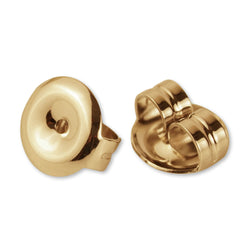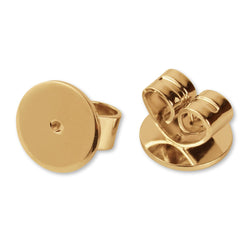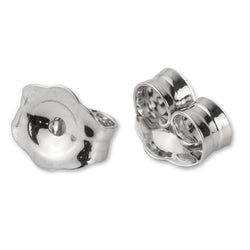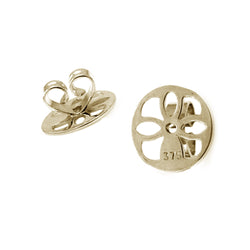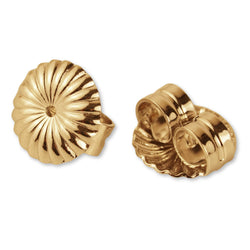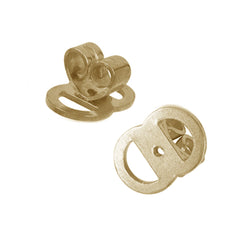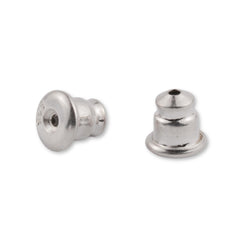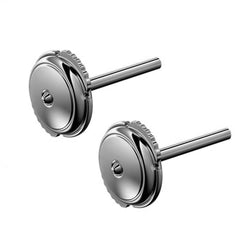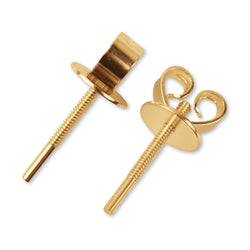Örhänge ryggar
Perfekt matchning för varje örhängedesign
Oavsett om du är en professionell juvelerare eller en gör-det-själv-entusiast, är våra baksidor med fjärilsörhängen avgörande för en säker och bekväm örhängeupplevelse. De passar till en rad olika typer av örhängen och passar perfekt med vårt utbud av örhängen , vilket säkerställer att dina örhängen sitter på plats med elegans och lätthet.
Vanliga frågor
Det säkraste bakstycket för örhängen anses ofta vara den gängade stolpen, som skruvas fast på en gängad örhängestolpe. Denna typ av baksida ger en låsmekanism som är mindre benägen att lossna, vilket gör den idealisk för värdefulla örhängen och för bärare som vill ha extra säkerhet.
Det vanligaste örhängestödet är fjärilsryggen, även känd som öronrullen eller push-back. Det används ofta på grund av dess enkelhet och användarvänlighet. Fjärilsryggar är lämpliga för en rad olika örhängestilar, från avslappnad till formell.
Olika typer av örhängen inkluderar:
- Butterfly Ear Backs/Scroll Backs: Dessa finns i olika stilar och utföranden, som passar över örhängets stolpe och håller det på plats.
- Stud Backs/Push Backs: En enkel, dubbliknande baksida som trycks på baksidan av ett örhänge.
- Silikonryggar: De kombineras ofta med metall och har en åtsittande passform och är idealiska för lättare örhängen.
- Gängade stolpsryggar: Kräv skruvning på en gängad örhängestolpe för ökad säkerhet.
- Fjäderbelastade ryggar: Har en fjädermekanism för ett säkrare grepp om örhängestolpen.
Earring backs come in various types, including butterfly backs, disc backs, threaded backs, silicone backs, and spring-loaded backs. Butterfly and disc backs are common for stud earrings, while threaded backs offer extra security for particularly valuable pieces. Silicone backs are lightweight and ultra-hypoallergenic, making them ideal for sensitive ears.
Choosing the right earring backs depends on the type of earring, desired aesthetic and the level of security needed. For studs, butterfly or disc backs are ideal. For heavy earrings, threaded backs provide extra security, while silicone backs are great for comfort and hypoallergenic properties.
Yes, sterling silver earring backs are generally suitable for sensitive ears. Sterling silver is hypoallergenic and less likely to cause irritation, especially when it’s nickel-free. Ensure that your sterling silver earring backs are of high quality to avoid any potential reactions
Using recycled metals in earring backs supports ethical jewellery practices and reduces environmental impact. Recycled metals help conserve natural resources and reduce waste, making them an excellent choice for sustainable jewellery making.
To secure your earrings with butterfly backs, insert the post through the ear and gently push the butterfly back onto the post until it’s snug against the ear. Ensure that the back is not too tight to avoid discomfort but secure enough to prevent the earring from falling out.
Yes, you can mix and match different metal earring backs in a single jewellery piece, especially if you are aiming for a mixed-metal look.
Disc earring backs are larger and provide a broader surface area, offering more stability and comfort, especially for heavier earrings. Classic butterfly backs are smaller and more discreet, ideal for lightweight earrings or when a minimal look is desired.
To care for gold earring backs, regularly clean them with a soft cloth and mild soap to remove oils and dirt. Store them in a dry, cool place away from direct sunlight to prevent tarnishing. Avoid exposing earring backs to harsh chemicals, such as chlorine or bleach.
Silicone earring backs are excellent for securing lightweight earrings. They provide a snug fit, are hypoallergenic, and are less likely to cause discomfort, making them ideal for everyday wear and sensitive ears.
To prevent tarnishing on sterling silver earring backs, store them in a dry, airtight container when not in use. Regularly clean them with a silver polishing cloth to remove any tarnish. Avoid exposing them to moisture, perfumes, and harsh chemicals, which can accelerate tarnishing.
No tools are required to use earring backs in jewellery making. Most earring backs can be easily attached and removed by hand without any specialized equipment.
Yes, earring backs can be used for both stud and drop earrings. Butterfly and disc backs are commonly used for studs, while some drop earrings use secure earring backs like threaded or spring-loaded types to ensure the earring stays in place.
To ensure a comfortable fit with earring backs, choose a size and style that fits securely without pinching or pressing too tightly against the ear. If you experience discomfort, try different back styles, such as silicone or disc backs, which offer more cushioning.
Attach earring backs by sliding them onto the earring post until they sit securely against the earlobe. For threaded posts, screw the back on gently until tight. Ensure the back is compatible with the post type to prevent slipping or falling off.
Yes, threaded earring backs are generally more secure than other types, as they screw onto the post, reducing the risk of the earring falling off. They are particularly recommended for valuable or heavy earrings where extra security is needed.
Choose between gold, silver, and platinum earring backs based on your metal preference, skin sensitivity, and the type of earrings. Gold and platinum are ideal for hypoallergenic properties, while sterling silver offers a classic look and is more affordable.
Yes, earring backs can be used for both casual and formal jewellery designs. The type of back used might differ; for instance, threaded backs may be preferred for formal, high-value pieces, while silicone backs might be chosen for casual, lightweight earrings.
Achieve a professional finish by choosing high-quality earring backs that match the earring post and design. Ensure the backs fit securely and are properly aligned. Regularly clean and polish the backs to maintain their appearance and avoid visible wear.
The most popular styles of earring backs for jewellery making include butterfly disc backs, round backs, and filigree earring backs. These styles are favored for their ease of use, comfort, and ability to secure various types of earrings effectively.
Spring-loaded earring backs offer a secure fit and are easier to attach and remove compared to traditional backs. They are ideal for those who want a hassle-free, secure option, especially for heavier earrings or when frequent adjustments are needed.
To create a secure and comfortable fit with floral earring backs, ensure they are appropriately sized for the earring post and earlobe. The design should distribute weight evenly across the lobe, preventing discomfort or slippage.
Yes, earring backs can be customized for bespoke jewellery pieces. You can choose specific metals, designs, and finishes to match the overall aesthetic of the earrings. Custom earring backs can enhance the uniqueness and quality of your jewellery.
The differences between 9ct, 14ct, and 18ct gold earring backs lie in their gold content, durability, and color. 9ct is harder and more affordable but has less gold. 14ct offers a balance of durability and rich color, while 18ct has the highest gold content, providing a deep color but is softer.
Store earring backs in a dry, airtight container or a soft jewellery pouch to prevent damage and tarnishing. Keep them separate from other jewellery to avoid scratches and ensure they maintain their shape and function over time.
Yes, earring backs can be used in both modern and vintage-inspired jewellery. The style of the back can enhance the overall design, whether you choose a classic, timeless look with floral or filigree backs or a sleek, minimalist style with modern backs.
Attach disc earring backs securely by sliding the back onto the post until it is snug against the ear. Ensure the disc is flat against the earlobe to provide stability, especially for larger or heavier earrings.
Clean and polish earring backs regularly using a soft cloth and mild jewellery cleaner. Avoid harsh chemicals that can damage the metal. For gold and platinum, use a jewellery polishing cloth to maintain their shine. For silver, a silver polishing cloth can help prevent tarnishing.
For heavy or large earrings, select earring backs that offer extra support, such as disc backs or threaded backs. These types provide stability and help distribute the weight of the earring, preventing sagging or discomfort.
Yes, you can use earring backs to create matching jewellery sets by choosing backs that complement the design of the earrings and other pieces in the set. Consistency in metal type, color, and style will ensure a cohesive and polished look.
High-quality earring backs should be made from durable, hypoallergenic materials, fit securely on the post, and be resistant to tarnishing. Look for smooth edges to avoid irritation, and ensure they provide a comfortable and stable fit for the earrings.
Earring backs are not entirely universal. While some types, such as butterfly backs and silicone stoppers, can fit various post sizes, others are specifically designed for certain earrings, like screw backs or locking backs. To ensure a secure fit, it’s important to select earring backs that are compatible with the size and style of your earrings.
Some cheaper earring backs are magnetic, particularly those designed for non-pierced earrings. These magnetic backs use small, powerful magnets to hold the earring in place on the earlobe. However, traditional gold and silver earring backs, such as butterfly or screw backs, are not magnetic.
Earring backs are known by several names depending on their design and function. Common types include butterfly backs, screw backs, friction backs, and push backs. Each type offers different levels of security and comfort, making them suitable for various earring styles.
To clean earring backs, soak them in warm, soapy water for a few minutes to loosen dirt and debris. Then, gently scrub them with a soft toothbrush, rinse with clean water, and dry with a soft cloth. For metal earring backs, a jewellery cleaning solution or a mixture of water and vinegar can help remove tarnish.
To remove earring backs, hold the earring front with one hand and carefully pull or twist the back off with the other. For screw backs, twist them counterclockwise to remove. Take care to work slowly to avoid damaging the earring or losing small parts.
To tighten earring backs, gently pinch the loops of a butterfly back closer together with your fingers or small pliers. This will create a tighter grip on the post. If the earring back is too loose and cannot be tightened, it’s best to replace it with a new one that fits securely.
If an earring back is stuck, try applying a small amount of baby oil or olive oil around the post and back to lubricate it. Gently wiggle the back while pulling it off. If it remains stuck, use tweezers for extra grip or consult a jeweller to prevent damage to the earring or your ear.
You can buy high-quality earring backs from reputable jewellery suppliers like Ore Metals, which offers a wide selection of earring backs in various styles and metals, including sterling silver, 9ct, 14ct, and 18ct yellow and rose gold. When purchasing earring backs, look for suppliers that provide detailed product information, such as metal type, design features, and size options, to ensure you select the right backs for your needs. Additionally, consider choosing suppliers that prioritize ethical sourcing and sustainable practices, so you can be confident in the quality and environmental responsibility of your purchase.
The best earring backs depend on your needs. Butterfly backs also known as ear scrolls, are known for their secure fit, while silicone backs are ideal for sensitive ears due to their hypoallergenic properties. Threaded backs are recommended for valuable earrings that require extra security. Choose based on the type of earring, comfort, and any allergies.
Yes, silicone ear backs are safe and are a great choice for those with sensitive skin or metal allergies. They are hypoallergenic, soft, and comfortable, making them suitable for everyday wear, especially if metal earring backs cause irritation.

